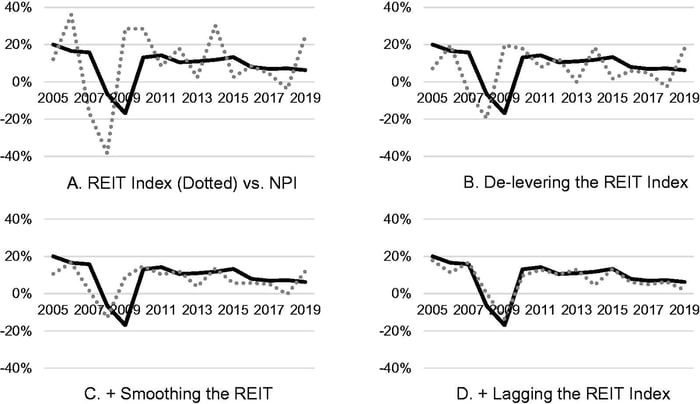Peer Intelligence | Winter 2023
Green urban development and benchmarking private real estate with listed proxies
By Chris Flynn
In October 2022, CEM’s Alexander Beath, Maaike van Bragt, and Quentin Spehner joined Sebastien Betermier of the Desautels Faculty of Management at McGill University, and Yuedan Liu of PSP Investments, in publishing “Green Urban Development: The Impact Investment Strategy of Canadian Pension Funds,” in the Journal of Sustainable Real Estate. The paper investigates the investment strategy of large Canadian pension funds in the private real estate market.
An initial observation was that between 2005 to 2019, large and more direct investors globally tended to outperform the benchmarks assigned by the researchers. However, large Canadian pension funds outperformed to an even greater degree. This outperformance begs the question: why?
To search for answers, the researchers proceeded to examine a key element of their real estate programs, finding that large Canadian funds systematically pursue an impact strategy consisting of the internal development, management, and ‘greening’ of urban properties. For example, by combing through LEED databases they find that large Canadian investors initiate and complete LEED projects on twice the proportion of portfolio assets as do non-Canadians. Indeed, Canadian pension funds are more likely to purchase real estate, activate & complete the LEED certification process, and then re-sell the assets.
That said, as CEM does not have property level returns, the researchers cannot specifically tie the outperformance of large Canadian funds in real estate to the strategy of green urban development. The pension funds themselves, of course, do see their own property level returns, and what they’ve seen has clearly encouraged them to continue pursuing the strategy.
The benchmarking methodology touches on another topic: how might we benchmark and compare global real estate portfolios? The benchmarks assigned by the researchers will be familiar to CEM’s Global Leaders, as we have used the approach to benchmark many private asset classes. This paper is the first time the method has been used in an academic paper and presented in this level of detail. A benchmark is constructed using a mixture of domestic and global REIT indices, (de-)levered with investment grade corporate bond indices, smoothed, and then lagged. The basic idea is that where listed real estate returns are market based, unlisted real estate returns are based instead on appraisals. The benchmarking method aims to simulate the appraisal process.
An example of the benchmarking method applied to an index (rather than a portfolio) is shown below for the NCREIF property index, a de-levered pure property real estate index. The example blends 48% REITs with 52% AAA bond index, then adds smoothing and a lag of 272 trading days (very close to a calendar year). The final correlation is 93% which is very high, showing remarkable tracking between the two.

The ability to construct benchmarks that reflect different geographic exposures and leverage provides a useful research tool to investigate the long-term performance of various real estate strategies and structures on a risk-adjusted basis. It also can be used as a tool for portfolio analysis or even benchmarking for investors. While smoothing and lag are applied to make the returns more comparable, the ultimate drivers of return in the proxy benchmark are REITs and corporate bonds which can be invested in as an alternative.
CEM is often asked about what sort of benchmarks should be used for various private asset classes. Most (though not all) real estate investors use a benchmark based on contributed, appraisal-based returns to private real estate portfolios. These benchmarks have the advantage of being well-recognized industry standards, are fair in that they are not easy to beat, and are often highly correlated to investors real estate portfolios. However, they also have the disadvantage of hiding (in plain sight!) the lag and smoothing that exists in appraised private asset portfolios, making them appear to be greater diversifiers then the really are.
Peer Intelligence | Winter 2023
